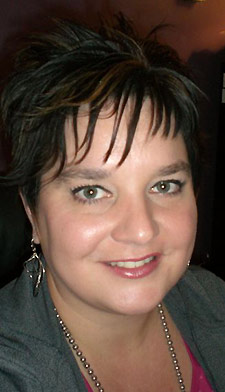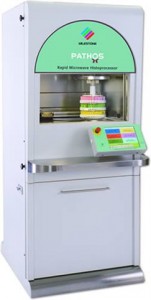 In almost every lab across the country, efforts to improve turnaround times, provide better service to patients and maintain a safe environment for staff are at the forefront. We are no different, if anything we have higher expectations placed upon us as the premier hospital in the nation. It is because of this fact that an effort to change “how we’ve always done it” has come with mixed reviews.
In almost every lab across the country, efforts to improve turnaround times, provide better service to patients and maintain a safe environment for staff are at the forefront. We are no different, if anything we have higher expectations placed upon us as the premier hospital in the nation. It is because of this fact that an effort to change “how we’ve always done it” has come with mixed reviews.
Routinely, the processing of a specimen in Surgical Pathology begins in accessioning, then moves to grossing for sectioning and is placed into fixative, normally 10% Neutral Buffered Formalin. The tissue cassettes are then picked up by a Histo tech at the end of the day, loaded onto a standard tissue processor on a 12 hour overnight processing schedule. The goal of processing is to remove all of the water from the tissue through a series of graded alcohols and xylenes; and then infiltrate the tissue with paraffin wax. This will allow the tissue to then be embedded, sectioned and placed on a slide for staining and pathologists’ review. This process has not changed in almost 100 years, this is histology.
Recently, as in the past 30 years, microwave technology has been explored as an alternative to routine processing. Microwaves (electromagnetic waves) are short pulses of energy that allow the solution that the tissue cassettes are submersed in to be heated evenly and are able to maintain that temperature over time. The overall benefit from this heat element alone is that the fixation and dehydration of the tissue occurs in about one third of the time. In essence, a routine specimen such as a radical prostatectomy, grossed at a thickness of 3mm, can be processed by our microwave processor in about 3 hours 45 minutes in comparison to a standard 12 hour processing schedule.
 The instrument that is used in the histology lab is the Pathos, manufactured by Milestone Medical Inc. Some of the features include separate retorts for the microwave chamber and the paraffin chamber. This allows us to run cycles back to back without the need to run a cleaning cycle after each run. There are multiple preset programs for tissue thicknesses from 1 mm to 5 mm, and the ability to customize our own processing cycles. These processing times run anywhere from 1 hour to 5 hours depending upon the thickness of the tissue. We utilize an isopropyl/ethanol alcohol blend to eliminate the need to use xylene. This reduces hazardous chemical exposure by the staff and reduces the overall amount of hazardous waste produced by the lab. Pathos, has a solution manager built in to the software. Based on the number of cassettes that are processed, the software calculates the usage and lifespan of the solutions. This allows us to monitor the exchanges and consumption of reagents much more accurately. The ease of the software makes the instrument very user friendly and the feedback from the staff has been very positive.
The instrument that is used in the histology lab is the Pathos, manufactured by Milestone Medical Inc. Some of the features include separate retorts for the microwave chamber and the paraffin chamber. This allows us to run cycles back to back without the need to run a cleaning cycle after each run. There are multiple preset programs for tissue thicknesses from 1 mm to 5 mm, and the ability to customize our own processing cycles. These processing times run anywhere from 1 hour to 5 hours depending upon the thickness of the tissue. We utilize an isopropyl/ethanol alcohol blend to eliminate the need to use xylene. This reduces hazardous chemical exposure by the staff and reduces the overall amount of hazardous waste produced by the lab. Pathos, has a solution manager built in to the software. Based on the number of cassettes that are processed, the software calculates the usage and lifespan of the solutions. This allows us to monitor the exchanges and consumption of reagents much more accurately. The ease of the software makes the instrument very user friendly and the feedback from the staff has been very positive.
We have faced many challenges in our validation process. Through trial and error, our tissue collection has improved dramatically. A coordination of efforts between the histology and grossing staff has allowed us to grow our tissue bank very rapidly in recent weeks. In a department this large, each service has its own set of requirements they would like to evaluate before signing off on the change in processing. This has created some delays in getting certain tissue types approved. While trying to advance the technology and improve the turnaround times of the specimens, we also want to show that microwave processing will give comparable results to the current method in a much shorter time frame.
One specific area that has been very sensitive to validate are the breast specimens. We have shown that the processing can be performed on large mastectomy samples in less than 5 hours and quality sections are being produced. The main Achilles’ heel with this tissue type is validating a large enough sampling of Her2Neu- 2+ positive cases. The additional breast immuno stains (ER/PR, Ki67, GCDFP and Mammoglobin) have resulted in comparable stain quality and clarity.
All in all, we have found the Pathos microwave processor to be an asset to the workflow and help us to distribute the workload more effectively. I would like to thank the pathologists’ who were very eager and excited to get on the microwave bandwagon to help us get this project started and appreciate their continued support.
You can learn more about the Pathos workflow on the milestone medical web site.
Deborah Duckworth, HTL (ASCP)
Histology Supervisor
How do you document the validation process when starting to pursue the microwave. Is there a chart used for temperature used in the validation process. Thank you
We created an extensive excel spreadsheet only because of the complexity of our services. The information includes tissue type, date & time submitted into fixative, processing protocol, date delivered to pathologist and return date, comments from pathologist (good or bad) and approved or not. Also any special stains, immuno or molecular tests reviewed were commented upon. It is a tedious process for sure.
We made minor adjustments to the standard protocols on the instrument and at the end of the run we save the data. This allows us to review all processing runs and verify times and temperatures. If there is a question related to processing.
I hope this helps. Thank you, Deborah
We are currently in the process of trying to validate our microwave processors (for IHC), and I am having trouble finding guidelines for this. Does there need to be a separate validation for each protocol on the microwave, we have two different protocols (one for small biopsies, and one for larger specimens). Also, not sure how many tissues need to be collected we were trying to collect 25 different cases, and that is becoming quite difficult as some of the tissues are quite rare. Any guidance with this would be very helpful. Thank you
Dear Deborah
Thank you for sharing with us about the Pathos.
We here at PathWest in Western Australia are looking at purchasing one or two microwave tissue processors for the rapid through put / same day reporting of gastrointestinal endoscopic (GE) biopsies to be placed at one or two of our major laboratory centres to cope with the increasing volume of GE biopsies and provide a consistent even flow of work through to the Pathologists. We have seen the Pathos Delta on the internet which is very similar to the Pathos.
Would you be so kind to offer us some advice when we consider the purchase of a rapid microwave tissue processor and any other comments about the Pathos product which were not listed above that my help us in our purchasing decision.
Many thanks
Geoff Swan